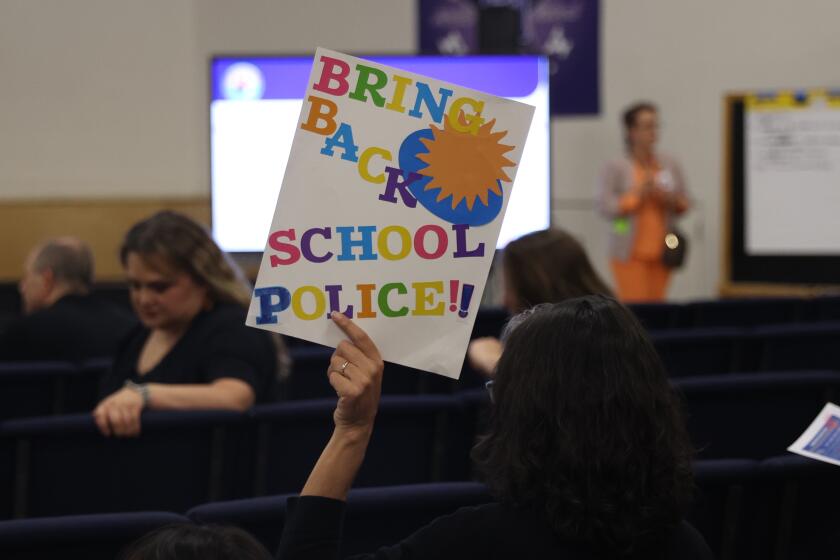Cleaner-Fuel School Buses Mandated
Southern California air-quality officials unanimously approved a measure Friday to require schools across the region to begin replacing heavily polluting diesel buses with cleaner-fueled models.
Diesel emissions have been linked to cancer, asthma and urban haze. The action by the South Coast Air Quality Management District board expands California’s offensive against diesel pollution by requiring districts to purchase cleaner-fueled buses whenever old ones are retired.
“Today marks the start of a healthier future for our young people. Our young people deserve the best start we can provide in both their environment and education,” said William Burke, chairman of the AQMD governing board.
According to AQMD officials, Friday’s decision marks the first time a smog-fighting agency anywhere in the country has mandated that school bus fleets switch to alternative fuels. The school bus measure affects 74 public and private school fleets, as well as several private contractors who operate 15 or more buses in Los Angeles, Orange, Riverside and San Bernardino counties.
Sandy Fiddler, transportation analyst for the Orange County department of education, said the county’s 29 public school districts can’t afford alternative-fueled buses. She predicted costs to transport students will jump 36%.
“Schools already have a huge number of priorities on their plates to meet the needs of our community and having the dictatorship of the AQMD come with one more mandate is not appropriate,” said Michael Fine, assistant superintendent for the Newport-Mesa Unified School District. “That’s forcing us to make a decision between books, computers, teachers and aides, and replacing school buses.”
To make the costly transition easier for financially strapped school districts, the AQMD will require the purchase of buses fueled with natural gas only if outside funds are available. If subsidies are not available, fleet operators may purchase improved diesel engines. And if funds run out for those vehicles, schools can buy conventional diesel buses equipped with soot traps, which capture 85% of the smoke.
Schools in the most polluted areas and those in low-income neighborhoods will have priority in securing funds.
About 8,800 school buses operate in the region, and air quality officials expect that 3,356 of the heavy-duty vehicles will be replaced with more environmentally friendly models or converted to run on cleaner fuel by 2007.
This year, the AQMD is able to provide about $27 million for the changeover and estimates that it can replace about 160 buses. An additional $14 million is available to pay for natural gas refueling stations. The regulation doesn’t go into effect for 90 days.
Already, the AQMD has received applications for funds to pay for 800 low-polluting buses. Air quality officials predict that more money will be available next year from state sources and from fines paid by manufacturers and power plants currently violating pollution controls.
The action was taken over strenuous objections from diesel engine makers, oil companies and some school officials who argued for replacing existing fleets exclusively with improved, low-polluting diesel motors. The proponents contend that such engines achieve comparable emission reductions for less cost.
The air quality board rejected those arguments and instead pledged to provide millions of dollars to help schools pay for clean, but costlier, natural gas-powered buses, although it allowed flexibility to reduce burdens and ensure a role for improved diesel technologies.
The board’s decision culminated a day of emotional public testimony at the district’s Diamond Bar headquarters as business representatives, educators, children and health advocates debated how far to push schools to cut smog without jeopardizing books and classroom supplies. The decision also concludes a two-year push by the AQMD to clean up a wide range of vehicle fleets, with previous measures aimed at street sweepers, trash trucks and taxicabs.
New technologies have resulted in buses that produce no visible smoke and dramatically fewer gaseous pollutants than older ones. Once fully implemented, the measure will lead to the removal of 96 tons of nitrogen oxides and soot annually, air quality officials predict. Those two pollutants rank among the chief airborne health threats for Southern Californians because they contribute to ozone, a toxic gas, and to tiny particles that evade the body’s defenses and lodge deep in human lungs.
About 70% of the 24,000 school buses in California are powered by diesel engines, many of them so old that they have no pollution controls.
“Why do school districts hang onto buses for 20, 30, 40 years?” asked David Walthall, director of transportation for the Ontario-Montclair School District. “It’s not because we have a sentimental attachment to them. It’s because we cannot afford to buy new ones.”
One study released in February by a national environmental group found that children riding in buses used by the Los Angeles Unified School District were exposed to nearly four times as much diesel exhaust as someone riding in a car or standing on a city street.
That study prompted Los Angeles Unified--which operates 2,600 school buses, the largest fleet in the state--to begin purchasing only natural gas buses, so long as outside funds are available to offset the higher cost.
Today’s improved diesel buses, when powered by low-sulfur fuel, produce 25% less nitrogen oxide and a fraction of the soot emitted by buses now in service. Natural gas models are cleaner still, emitting one-third less nitrogen oxide than the retooled diesel engines.
Environmentalists, who made clean school buses a top priority for California this year, hailed the new regulation as a major step toward protecting children’s health.
They prevailed upon Gov. Gray Davis last year to include $50 million in the state budget for clean school buses.
But education officials worry that, even with the subsidies, the regulation will bust budgets at schools struggling to pay for classroom materials. “The new regulation obviously is going to cost school districts more money,” said Dan Crawford, associate superintendent in charge of support services for the Capistrano Unified School District, which has about 180 buses. “That’s a major concern of every school district.”
The Garden Grove Unified School District, with a fleet of more than 100 buses, has remained officially neutral on the proposal. But Ron Suttle, director of facilities, said they are “very concerned about having to spend more of the kids’ money on infrastructure and retrofitting.”
More to Read
Start your day right
Sign up for Essential California for news, features and recommendations from the L.A. Times and beyond in your inbox six days a week.
You may occasionally receive promotional content from the Los Angeles Times.






